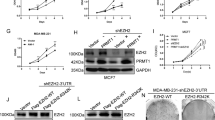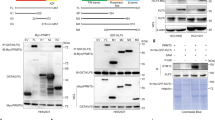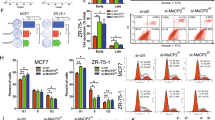Abstract
Human protein arginine N-methyltransferase 2 (PRMT2, HRMT1L1) is a protein that belongs to the arginine methyltransferase family, and it has diverse roles in transcriptional regulation through different mechanisms depending on its binding partners. In this study, we provide evidences for the negative effect of PRMT2 on breast cancer cell proliferation in vitro and in vivo. Morever, cyclin D1, one of the key modulators of cell cycle, was found to be downregulated by PRMT2, and PRMT2 was further shown to suppress the estrogen receptor α-binding affinity to the activator protein-1 (AP-1) site in cyclin D1 promoter through indirect binding with AP-1 site, resulting in the inhibition of cyclin D1 promoter activity in MCF-7 cells. Furthermore, a positive correlation between the expression of PRMT2 and cyclin D1 was confirmed in the breast cancer tissues by using tissue microarray assay. In addition, PRMT2 was found to show a high absent percentage in breast caner cell nuclei and the nuclear loss ratio of PRMT2 was demonstrated to positively correlate with cyclin D1 expression and the increasing tumor grade of invasive ductal carcinoma. Those results offer an essential insight into the effect of PRMT2 on breast carcinogenesis, and PRMT2 nuclear loss might be an important biological marker for the diagnosis of breast cancer.
This is a preview of subscription content, access via your institution
Access options
Subscribe to this journal
Receive 50 print issues and online access
$259.00 per year
only $5.18 per issue
Buy this article
- Purchase on Springer Link
- Instant access to full article PDF
Prices may be subject to local taxes which are calculated during checkout









Similar content being viewed by others
References
Sayeed A, Konduri SD, Liu W, Bansal S, Li F, Das GM . Estrogen receptor alpha inhibits p53-mediated transcriptional repression: implications for the regulation of apoptosis. Cancer Res 2007; 67: 7746–7755.
Feng Y, Manka D, Wagner KU, Khan SA . Estrogen receptor-alpha expression in the mammary epithelium is required for ductal and alveolar morphogenesis in mice. Proc Natl Acad Sci USA 2007; 104: 14718–14723.
Le Romancer M, Poulard C, Cohen P, Sentis S, Renoir JM, Corbo L . Cracking the estrogen receptor's posttranslational code in breast tumors. Endocr Rev 2011; 32: 597–622.
Ferguson AT, Davidson NE . Regulation of estrogen receptor alpha function in breast cancer. Crit Rev Oncog 1997; 8: 29–46.
Metivier R, Penot G, Hubner MR, Reid G, Brand H, Kos M et al. Estrogen receptor-alpha directs ordered, cyclical, and combinatorial recruitment of cofactors on a natural target promoter. Cell 2003; 115: 751–763.
Saville B, Wormke M, Wang F, Nguyen T, Enmark E, Kuiper G et al. Ligand-, cell-, and estrogen receptor subtype (alpha/beta)-dependent activation at GC-rich (Sp1) promoter elements. J Biol Chem 2000; 275: 5379–5387.
DeNardo DG, Kim HT, Hilsenbeck S, Cuba V, Tsimelzon A, Brown PH . Global gene expression analysis of estrogen receptor transcription factor cross talk in breast cancer: identification of estrogen-induced/activator protein-1-dependent genes. Mol Endocrinol 2005; 19: 362–378.
Stein B, Yang MX . Repression of the interleukin-6 promoter by estrogen receptor is mediated by NF-kappa B and C/EBP beta. Mol Cell Biol 1995; 15: 4971–4979.
Cheng AS, Jin VX, Fan M, Smith LT, Liyanarachchi S, Yan PS et al. Combinatorial analysis of transcription factor partners reveals recruitment of c-MYC to estrogen receptor-alpha responsive promoters. Mol Cell 2006; 21: 393–404.
Bocchinfuso WP, Korach KS . Mammary gland development and tumorigenesis in estrogen receptor knockout mice. J Mammary Gland Biol Neoplasia 1997; 2: 323–334.
Eeckhoute J, Carroll JS, Geistlinger TR, Torres-Arzayus MI, Brown M . A cell-type-specific transcriptional network required for estrogen regulation of cyclin D1 and cell cycle progression in breast cancer. Genes Dev 2006; 20: 2513–2526.
Klein EA, Assoian RK . Transcriptional regulation of the cyclin D1 gene at a glance. J Cell Sci 2008; 121: 3853–3857.
Katsanis N, Yaspo ML, Fisher EM . Identification and mapping of a novel human gene, HRMT1L1, homologous to the rat protein arginine N-methyltransferase 1 (PRMT1) gene. Mamm Genome 1997; 8: 526–529.
Scott HS, Antonarakis SE, Lalioti MD, Rossier C, Silver PA, Henry MF . Identification and characterization of two putative human arginine methyltransferases (HRMT1L1 and HRMT1L2). Genomics 1998; 48: 330–340.
Qi C, Chang J, Zhu Y, Yeldandi AV, Rao SM, Zhu Y-J . Identification of protein arginine methyltransferase 2 as a coactivator for estrogen receptor alpha. J Biol Chem 2002; 277: 28624–28630.
Meyer R, Wolf SS, Obendorf M . PRMT2, a member of the protein arginine methyltransferase family, is a coactivator of the androgen receptor. J Steroid Biochem Mol Biol 2007; 107: 1–14.
Herrmann F, Pably P, Eckerich C, Bedford MT, Fackelmayer FO . Human protein arginine methyltransferases in vivo—distinct properties of eight canonical members of the PRMT family. J Cell Sci 2009; 122: 667–677.
Lakowski TM, Frankel A . Kinetic analysis of human protein arginine N-methyltransferase 2: formation of monomethyl- and asymmetric dimethyl-arginine residues on histone H4. Biochem J 2009; 421: 253–261.
Blythe SA, Cha SW, Tadjuidje E, Heasman J, Klein PS . Beta-catenin primes organizer gene expression by recruiting a histone H3 arginine 8 methyltransferase, Prmt2. Dev Cell 2010; 19: 220–231.
Iwasaki H, Kovacic JC, Olive M, Beers JK, Yoshimoto T, Crook MF et al. Disruption of protein arginine N-methyltransferase 2 regulates leptin signaling and produces leanness in vivo through loss of STAT3 methylation. Circ Res 2010; 107: 992–1001.
Yildirim AO, Bulau P, Zakrzewicz D, Kitowska KE, Weissmann N, Grimminger F et al. Increased protein arginine methylation in chronic hypoxia: role of protein arginine methyltransferases. Am J Respir Cell Mol Biol 2006; 35: 436–443.
Besson V, Brault V, Duchon A, Togbe D, Bizot J-C, Quesniaux VFJ et al. Modeling the monosomy for the telomeric part of human chromosome 21 reveals haploinsufficient genes modulating the inflammatory and airway responses. Hum Mol Genet 2007; 16: 2040–2052.
Ganesh L, Yoshimoto T, Moorthy NC, Akahata W, Boehm M, Nabel EG et al. Protein Methyltransferase 2 inhibits NF-{kappa}B function and promotes apoptosis. Mol Cell Biol 2006; 26: 3864–3874.
Zhong J, Cao RX, Zu XY, Hong T, Yang J, Liu L et al. Identification and characterization of novel spliced variants of PRMT2 in breast carcinoma. FEBS J 2012; 279: 316–335.
Chung K-H, Hart CC, Al-Bassam S, Avery A, Taylor J, Patel PD et al. Polycistronic RNA polymerase II expression vectors for RNA interference based on BIC/miR-155. Nucleic Acids Res 2006; 34: e53.
Fu M, Wang C, Li Z, Sakamaki T, Pestell RG . Minireview: CYCLIN D1: normal and abnormal functions. Endocrinology 2004; 145: 5439–5447.
Ong CS, Zhou J, Ong CN, Shen HM . Luteolin induces G1 arrest in human nasopharyngeal carcinoma cells via the Akt-GSK-3beta-Cyclin D1 pathway. Cancer Lett 2010; 298: 167–175.
Takahashi-Yanaga F, Sasaguri T . GSK-3beta regulates cyclin D1 expression: a new target for chemotherapy. Cell Signal 2008; 20: 581–589.
Ye X, Guo Y, Zhang Q, Chen W, Hua X, Liu W et al. BetaKlotho suppresses tumor growth in hepatocellular carcinoma by regulating Akt/GSK-3beta/cyclin D1 signaling pathway. PLoS One 2013; 8: e55615.
Lin W-J, Gary JD, Yang MC, Clarke S, Herschman HR . The mammalian immediate-early TIS21 protein and the leukemia-associated BTG1 protein interact with a protein-arginine N-methyltransferase. J Biol Chem 1996; 271: 15034–15044.
McBride AE, Silver PA . State of the arg: protein methylation at arginine comes of age. Cell 2001; 106: 5–8.
Chen SL, Loffler KA, Chen D, Stallcup MR, Muscat GEO . The coactivator-associated arginine methyltransferase is necessary for muscle differentiation. CARM1 coactivates myocyte enhancer factor-2. J Biol Chem 2002; 277: 4324–4333.
Torres-Padilla ME, Parfitt DE, Kouzarides T, Zernicka-Goetz M . Histone arginine methylation regulates pluripotency in the early mouse embryo. Nature 2007; 445: 214–218.
Lukong KE, Richard S . Arginine methylation signals mRNA export. Nat Struct Mol Biol 2004; 11: 914–915.
Meister G, Fischer U . Assisted RNP assembly: SMN and PRMT5 complexes cooperate in the formation of spliceosomal UsnRNPs. EMBO J 2002; 21: 5853–5863.
Li H, Park S, Kilburn B, Jelinek MA, Henschen-Edman A, Aswad DW et al. Lipopolysaccharide-induced methylation of HuR, an mRNA-stabilizing protein, by CARM1. J Biol Chem 2002; 277: 44623–44630.
Zhong J, Cao RX, Hong T, Yang J, Zu XY, Xiao XH et al. Identification and expression analysis of a novel transcript of the human PRMT2 gene resulted from alternative polyadenylation in breast cancer. Gene 2011; 487: 1–9.
Goulet I, Gauvin G, Boisvenue S, Cote J . Alternative splicing yields protein arginine methyltransferase 1 isoforms with distinct activity, substrate specificity, and subcellular localization. J Biol Chem 2007; 282: 33009–33021.
El Messaoudi S, Fabbrizio E, Rodriguez C, Chuchana P, Fauquier L, Cheng D et al. Coactivator-associated arginine methyltransferase 1 (CARM1) is a positive regulator of the Cyclin E1 gene. Proc Natl Acad Sci USA 2006; 103: 13351–13356.
Thomassen M, Tan Q, Kruse TA . Gene expression meta-analysis identifies chromosomal regions and candidate genes involved in breast cancer metastasis. Breast Cancer Res Treat 2009; 113: 239–249.
Yoshimoto T, Boehm M, Olive M, Crook MF, San H, Langenickel T et al. The arginine methyltransferase PRMT2 binds RB and regulates E2F function. Exp Cell Res 2006; 312: 2040–2053.
Katzenellenbogen BS, Montano MM, Ediger TR, Sun J, Ekena K, Lazennec G et al. Estrogen receptors: selective ligands, partners, and distinctive pharmacology. Recent Prog Horm Res 2000; 55: 163–193 discussion 194-165.
Baldin V, Lukas J, Marcote MJ, Pagano M, Draetta G . Cyclin D1 is a nuclear protein required for cell cycle progression in G1. Genes Dev 1993; 7: 812–821.
Arnold A, Papanikolaou A . Cyclin D1 in breast cancer pathogenesis. J Clin Oncol 2005; 23: 4215–4224.
Steeg PS, Zhou Q . Cyclins and breast cancer. Breast Cancer Res Treat 1998; 52: 17–28.
Sabbah M, Courilleau D, Mester J, Redeuilh G . Estrogen induction of the cyclin D1 promoter: involvement of a cAMP response-like element. Proc Natl Acad Sci USA 1999; 96: 11217–11222.
Castro-Rivera E, Samudio I, Safe S . Estrogen regulation of cyclin D1 gene expression in ZR-75 breast cancer cells involves multiple enhancer elements. J Biol Chem 2001; 276: 30853–30861.
Albanese C, Johnson J, Watanabe G, Eklund N, Vu D, Arnold A et al. Transforming p21ras mutants and c-Ets-2 activate the cyclin D1 promoter through distinguishable regions. J Biol Chem 1995; 270: 23589–23597.
Shen Q, Uray IP, Li Y, Krisko TI, Strecker TE, Kim HT et al. The AP-1 transcription factor regulates breast cancer cell growth via cyclins and E2F factors. Oncogene 2008; 27: 366–377.
Marampon F, Casimiro MC, Fu M, Powell MJ, Popov VM, Lindsay J et al. Nerve growth factor regulation of cyclin D1 in PC12 cells through a p21RAS extracellular signal-regulated kinase pathway requires cooperative interactions between Sp1 and nuclear factor-kappaB. Mol Biol Cell 2008; 19: 2566–2578.
Bartusel T, Schubert S, Klempnauer KH . Regulation of the cyclin D1 and cyclin A1 promoters by B-Myb is mediated by Sp1 binding sites. Gene 2005; 351: 171–180.
Tashiro E, Tsuchiya A, Imoto M . Functions of cyclin D1 as an oncogene and regulation of cyclin D1 expression. Cancer Sci 2007; 98: 629–635.
Kim JK, Diehl JA . Nuclear cyclin D1: an oncogenic driver in human cancer. J Cell Physiol 2009; 220: 292–296.
Ye Y, Xiao Y, Wang W, Yearsley K, Gao JX, Shetuni B et al. ERalpha signaling through slug regulates E-cadherin and EMT. Oncogene 2010; 29: 1451–1462.
Kawakubo H, Brachtel E, Hayashida T, Yeo G, Kish J, Muzikansky A et al. Loss of B-cell translocation gene-2 in estrogen receptor-positive breast carcinoma is associated with tumor grade and overexpression of cyclin d1 protein. Cancer Res 2006; 66: 7075–7082.
Zu X, Ma J, Liu H, Liu F, Tan C, Yu L et al. Pro-oncogene Pokemon promotes breast cancer progression by upregulating survivin expression. Breast Cancer Res 2011; 13: R26.
Acknowledgements
This work is supported by projects from the National Natural Science Foundation of P.R.China (Grant No. 31200573, 81272906, 81272355 and 81172542), Hunan Provincial Natural Science Foundation of China (12JJ3116) and The Education Department of Hunan Province Youth Fund (12B108).
Author information
Authors and Affiliations
Corresponding authors
Ethics declarations
Competing interests
The authors declare no conflict of interest.
Additional information
Supplementary Information accompanies this paper on the Oncogene website
Rights and permissions
About this article
Cite this article
Zhong, J., Cao, RX., Liu, JH. et al. Nuclear loss of protein arginine N-methyltransferase 2 in breast carcinoma is associated with tumor grade and overexpression of cyclin D1 protein. Oncogene 33, 5546–5558 (2014). https://doi.org/10.1038/onc.2013.500
Received:
Revised:
Accepted:
Published:
Issue Date:
DOI: https://doi.org/10.1038/onc.2013.500
Keywords
This article is cited by
-
Protein arginine methyltransferases: promising targets for cancer therapy
Experimental & Molecular Medicine (2021)
-
Protein arginine methyltransferases: insights into the enzyme structure and mechanism at the atomic level
Cellular and Molecular Life Sciences (2019)
-
Protein arginine methylation: an emerging regulator of the cell cycle
Cell Division (2018)
-
The association between S100A13 and HMGA1 in the modulation of thyroid cancer proliferation and invasion
Journal of Translational Medicine (2016)
-
Transformer2 proteins protect breast cancer cells from accumulating replication stress by ensuring productive splicing of checkpoint kinase 1
Frontiers of Chemical Science and Engineering (2016)



